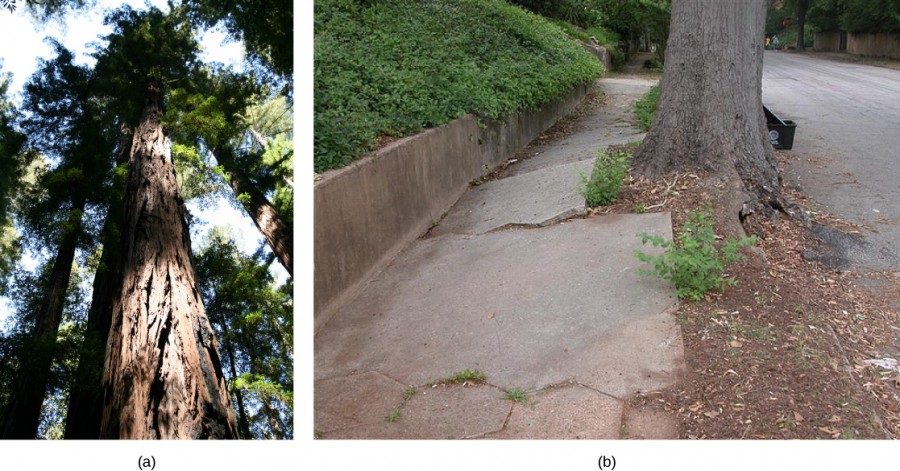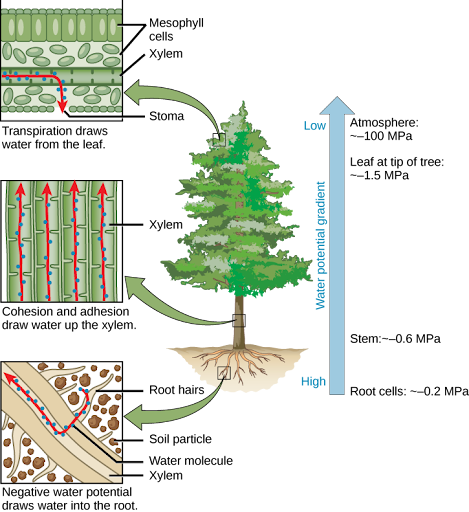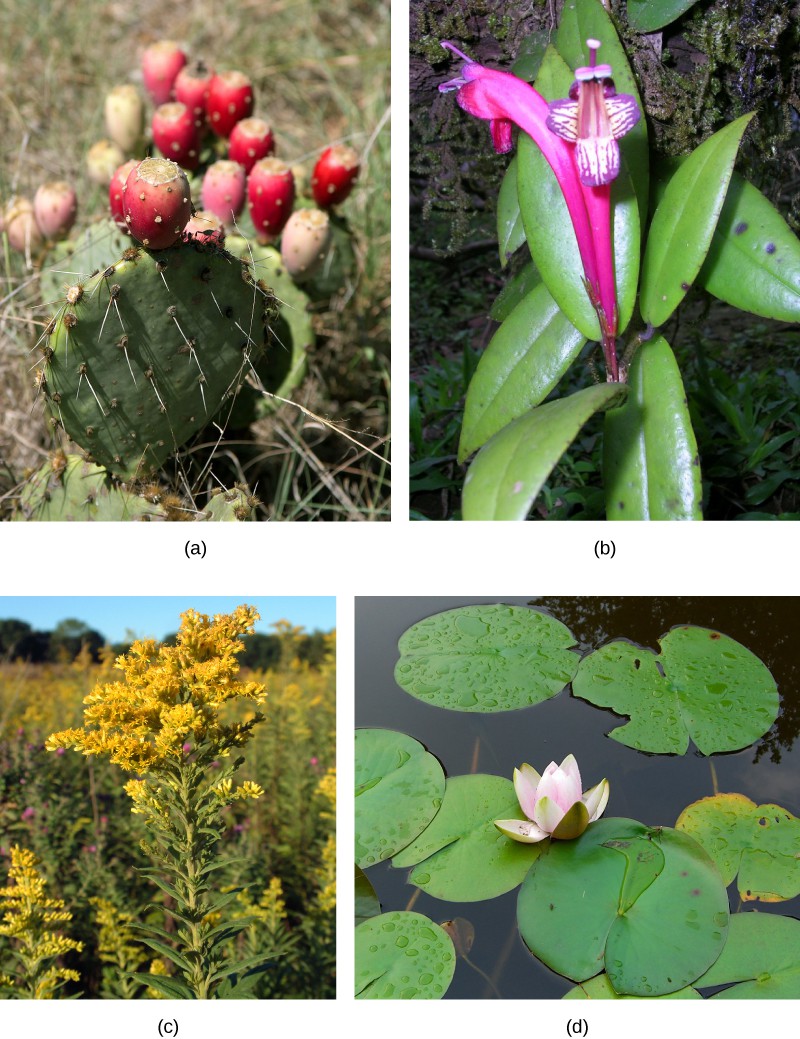Transport of Water in Plants
Section Goals
By the end of this section, you will be able to do the following:
- Describe how water potential, transpiration, and stomatal regulation influence how water is transported in plants.
The structure of plant roots, stems, and leaves facilitates the transport of water, nutrients, and photosynthates throughout the plant. The phloem and xylem are the main tissues responsible for this movement. Water potential, transpiration, and stomatal regulation influence how water and nutrients are transported in plants.
Plants are phenomenal hydraulic engineers. Using only the basic laws of physics and the simple manipulation of potential energy, plants can move water to the top of a 116-meter-tall tree (Figure 1a). Plants can also use hydraulics to generate enough force to split rocks and buckle sidewalks (Figure 1b). Plants achieve this because of water potential, a measure of the potential energy in water. The water potential in plant solutions is influenced by solute concentration, pressure, gravity, and factors called matrix effects. Water moves from an area of higher total water potential to an area of lower total water potential.

Check out this cool animation that follows the path of water from roots to tips and beyond in a Douglas fir tree:
Movement of Water and Minerals in the Xylem via Transpiration
Transpiration is the loss of water from the plant through evaporation at the leaf surface. It is the main driver of water movement in the xylem. Transpiration is caused by the evaporation of water at the leaf–atmosphere interface; it creates negative pressure (tension) equivalent to –2 MPa at the leaf surface. This value varies greatly depending on the vapor pressure deficit, which can be negligible at high relative humidity (RH) and substantial at low RH. This tension pulls water from the roots up. At night, when stomata shut and transpiration stops, the water is held in the stem and leaf by the adhesion of water to the cell walls of the xylem vessels and tracheids and the cohesion of water molecules to each other. This explanation is called the cohesion–tension theory of sap ascent.

Inside the leaf at the cellular level, water on the surface of mesophyll cells saturates the cellulose microfibrils of the primary cell wall. The leaf contains many large intercellular air spaces for the exchange of oxygen for carbon dioxide, which is required for photosynthesis. The wet cell wall is exposed to this leaf-internal air space, and the water on the surface of the cells evaporates into the air spaces, decreasing the thin film on the surface of the mesophyll cells.
This decrease creates a greater tension on the water in the mesophyll cells (Figure 2), thereby increasing the pull on the water in the xylem vessels. The xylem vessels and tracheids are structurally adapted to cope with large changes in pressure. Rings in the vessels maintain their tubular shape, much like the rings on a vacuum cleaner that keep the hose open while it is under pressure. Small perforations between vessel elements reduce the number and size of gas bubbles that can form via a process called cavitation. The formation of gas bubbles in the xylem interrupts the continuous stream of water from the base to the top of the plant, causing a break termed an embolism in the flow of xylem sap. The taller the tree, the greater the tension forces needed to pull water and the more cavitation events. In larger trees, the resulting embolisms can plug xylem vessels, making them non-functional.
Did I Get It?
Transpiration—the loss of water vapor to the atmosphere through stomata—is a passive process, meaning that metabolic energy in the form of ATP is not required for water movement. The energy driving transpiration is the difference in energy between the water in the soil and the water in the atmosphere. However, transpiration is tightly controlled.
Control of Transpiration
The atmosphere to which the leaf is exposed drives transpiration but also causes massive water loss from the plant. Up to 90 percent of the water taken up by roots may be lost through transpiration.
Leaves are covered by a waxy cuticle on the outer surface that prevents the loss of water. Regulation of transpiration, therefore, is achieved primarily through the opening and closing of stomata on the leaf surface. Stomata are surrounded by two specialized cells called guard cells, which open and close in response to environmental cues such as light intensity and quality, leaf water status, and carbon dioxide concentrations. Stomata must open to allow air containing carbon dioxide and oxygen to diffuse into the leaf for photosynthesis and respiration. When stomata are open, however, water vapor is lost to the external environment, increasing the rate of transpiration. Therefore, plants must maintain a balance between efficient photosynthesis and water loss.
Over time, plants have evolved to adapt to their local environment and reduce transpiration (Figure 3). Desert plants (xerophytes) and plants that grow on other plants (epiphytes) have limited access to water. Such plants usually have a much thicker waxy cuticle than those growing in more moderate, well-watered environments (mesophytes). Aquatic plants (hydrophytes) also have their own set of anatomical and morphological leaf adaptations.

Xerophytes and epiphytes often have a thick covering of trichomes or stomata that are sunken below the leaf’s surface. Trichomes are specialized hair-like epidermal cells that secrete oils and substances. These adaptations impede airflow across the stomatal pore and reduce transpiration. Multiple epidermal layers are also commonly found in these types of plants.
Watch this video to review how transpiration works in plants and the factors that affect transpiration rate:
Did I Get It?
CC Licensed Content, Shared Previously, Included in Plant Form and Physiology
- Biology 2e. Authors: Mary Ann Clark, Matthew Douglas and Jung Choi. Provided by: OpenStax CNX. Located at: Biology 2e. License: CC BY: Attribution 4.0.
- Biology for Majors II. Authors: Shelly Carter and Monisha Scott. Provided by: Lumen Learning. Located at: Biology for Majors II | Simple Book Production. License: CC BY: Attribution 4.0.

